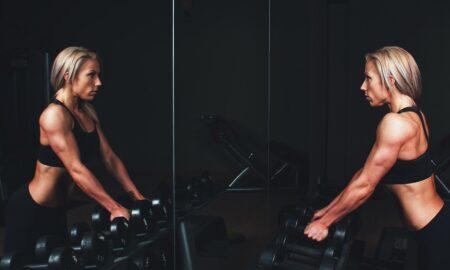 One of the most popular exercises in serious gyms is the dumbbell row. It’s an easy lift to learn and works the large muscles of the upper body, producing far less lower-back discomfort than a barbell row.
One of the most popular exercises in serious gyms is the dumbbell row. It’s an easy lift to learn and works the large muscles of the upper body, producing far less lower-back discomfort than a barbell row.
The dumbbell row works the large latissimus dorsi muscles of the midback; the teres major, or upper lats; the middle and lower trapezius; the rhomboids and the rear delts, as well as the biceps, brachialis, brachioradialis and gripping muscles. The lats, upper lats and rear delts pull the upper arm backward. The middle and lower trapezius and rhomboids pull the shoulder blades closer to the spine. The biceps, brachialis and brachioradialis muscles of the arm bend, or flex, the elbow. So, as you can see, rowing motions target a significant amount of muscle mass.
Many trainees include the barbell row in the early stage of their training, but it’s often dropped later for various reasons, usually lower-back pain. Trainees try to keep their upper body very still as they row, but it becomes more difficult to maintain that position as the weight increases. Other trainees move to doing the bent-over row standing on a bench, which enables them to touch the bar to the bench and then pull it toward them as their upper body returns to a position parallel to the floor. That variation usually limits the amount of weight that can be used.
Many iron legends have rowed incredible weights. Hall of Fame powerlifter David Shaw, Barbarian Brothers David and Peter Paul, former NFL strongman Pete Koch (remembered for his role as Swede in Clint Eastwood’s “Heartbreak Ridge”) and former Mr. Olympia Samir Bannout all performed barbell rows with 500 pounds. Eventually, even very strong trainees like them let the barbell row fall by the wayside. Very heavy dumbbell rows, with 220-pounders, became a viable substitute.
There’s more than one way to perform a dumbbell row. One method that evolved and is believed to be very “strict” is to place one hand and one knee on a bench with the other foot on the floor and the dumbbell hanging down. Then you pull the weight in a very strict manner. There certainly are situations where that form is beneficial. If a patient has just returned from a shoulder or lower back injury or surgery, the knee on the bench will allow only so much weight to be used and only so much force to be exerted. Beginners are often taught to perform dumbbell rows that way. Once the dumbbell become relatively heavy, however, it’s difficult to maintain balance with one knee on the bench.
There’s much discussion today of “stability training,” in which trainees are placed in unstable settings to force them to use various muscles to stabilize their core. The concept is a topic for another day, but there are limits to that form of training. To lift heavier weights, you must work from a stable platform. The most extreme example is Olympic weightlifting, where the lifters pull from a solid wood platform and wear lifting shoes, which are very stiff. Once they’re in a very stable position, they can pull the greatest weights at significant speed and acceleration. I assure you they have very strong cores.
The same can apply to the dumbbell row. If you have both feet on the floor, spread them apart a little bit, and move the leg that’s on the same side as the dumbbell back a little, your free hand can support you on the bench. That puts you in a tripodlike position, which is very stable. You pull the dumbbell as in any row. You can let your upper body rotate slightly as you pull—the paraspinal muscles will be activated more with the slight rotation. Another variation is to pull the dumbbell toward a point where the front pocket of your sweat pants or shorts would be. That angle gives you a stronger pull than you’d get by trying to pull the dumbbell toward your chest, which could affect how your shoulder blades are pulled back.
Train smart. That will let you remain in the gym making more gains.
—Joseph M. Horrigan
Editor’s note: Visit www.SoftTissueCenter.com for reprints of Horrigan’s past Sportsmedicine columns that have appeared in IRON MAN. You can order the books Strength, Conditioning and Injury Prevention for Hockey by Joseph Horrigan, D.C., and E.J. “Doc” Kreis, D.A., and the 7-Minute Rotator Cuff Solution by Horrigan and Jerry Robinson from Home Gym Warehouse, (800) 447-0008 or at www.Home-Gym.com.




















You must be logged in to post a comment Login